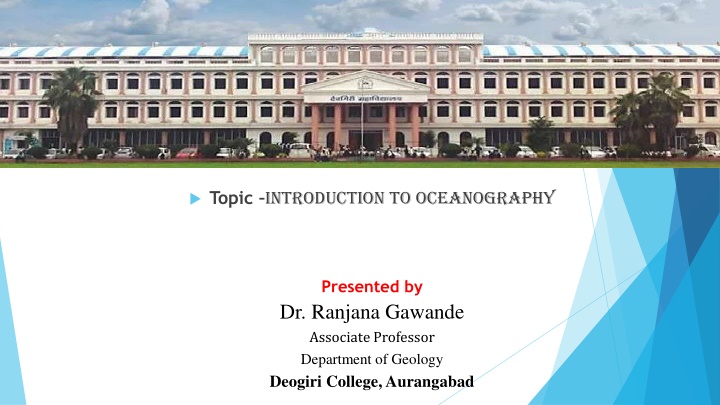
Exploring the Depths: An Overview of Oceanography by Dr. Ranjana Gawande
Delve into the fascinating world of oceanography with Dr. Ranjana Gawande, an Associate Professor at Deogiri College, Aurangabad. Discover the origins, composition, and distribution of Earth's oceans, as well as the methods and advanced technologies used by scientists to study them. From historical expeditions to modern satellite monitoring, this presentation provides a comprehensive introduction to the study of our planet's vast oceans.
Download Presentation

Please find below an Image/Link to download the presentation.
The content on the website is provided AS IS for your information and personal use only. It may not be sold, licensed, or shared on other websites without obtaining consent from the author. If you encounter any issues during the download, it is possible that the publisher has removed the file from their server.
You are allowed to download the files provided on this website for personal or commercial use, subject to the condition that they are used lawfully. All files are the property of their respective owners.
The content on the website is provided AS IS for your information and personal use only. It may not be sold, licensed, or shared on other websites without obtaining consent from the author.
E N D
Presentation Transcript
Topic Introduction to oceanography Presented by Dr. Ranjana Gawande Associate Professor Department of Geology Deogiri College, Aurangabad
Introduction to oceanography Dr. Ranjana Gawande Associate Professor Deogiri college, Aurangabad
Objectives Identify methods used by scientists to study Earth s oceans. The Oceans Discuss the origin and composition of the oceans. Describe the distribution of oceans and major seas.
The Oceans Oceanography is the scientific study of Earth s oceans. In the late 1800s, the British Challenger expedition became the first research ship to use relatively sophisticated measuring devices to study the oceans. The Oceans
Modern Oceanography In the 1920s, the German research ship Meteor used sonar for the first time to map the seafloor features of the South Atlantic Ocean. The Oceans Sonar, which stands for sound navigation and ranging, uses the return time of an echo and the known velocity of sound in water to determine water depth. The velocity of sound in water is 1500 m/s. To calculate the distance to the ocean floor, multiply the time by 1500 m/s, then divide by 2.
Origin of the Oceans Studies of radioactive isotopes indicate that Earth is about 4.6 billion years old. The Oceans Radioactive studies and lava flows offer evidence that there has been abundant water throughout Earth s geologic history.
Modern Oceanography Advanced Technology The Oceans Satellites such as the Topex/Poseidon continually monitor the ocean s surface temperatures, currents, and wave conditions. Submersibles, or underwater vessels, investigate the deepest ocean trenches. Large portions of the seafloor have been mapped using side-scan sonar. Side-scan sonar is a technique that directs sound waves to the seafloor at an angle, so that the sides of underwater hills and other topographic features can be mapped.
Origin of the Oceans Where did the water come from? The Oceans Scientists hypothesize that Earth s water could have originated from two sources. Comets occasionally collide with Earth and release water on impact possibly enough to have filled the ocean basins over geologic time. Studies of meteorites indicate that they may contain up to 0.5 percent water. If the early Earth contained the same percentage of water, it would have been more than sufficient to form the early oceans.
Origin of the Oceans Volcanism The Oceans Shortly after the formation of Earth, violent volcanism released huge amounts of water vapor, carbon dioxide, and other gases, which combined to form Earth s early atmosphere. As Earth s crust cooled, the water vapor gradually condensed into oceans.
Distribution of Earths Water The oceans contain 97 percent of the water found on Earth. The Oceans The remaining 3 percent is freshwater located in the frozen ice caps of Greenland and Antarctica and in rivers, lakes, and underground sources. The percentage of ice has ranged from near zero to as much as 10 percent of the hydrosphere over geologic time.
Distribution of Earths Water The Blue Planet The Oceans Approximately 71 percent of Earth s surface is covered by oceans that have an average depth of 3800 m. Because most landmasses are in the northern hemisphere, oceans only cover 61 percent of the surface. Water covers 81 percent of the southern hemisphere.
Distribution of Earths Water Major Oceans The Oceans There are three major oceans: The largest ocean, the Pacific, contains roughly half of Earth s seawater and is larger than all of Earth s landmasses combined. The second-largest ocean, the Atlantic, extends from Antarctica to the arctic circle, north of which it is often referred to as the Arctic Ocean. The third-largest ocean, the Indian, is located mainly in the southern hemisphere. The water surrounding Antarctica, south of 50 south latitude, is known as the Antarctic Ocean.
Distribution of Earths Water Major Oceans The Oceans
Distribution of Earths Water Sea Ice The Oceans The Arctic and Antarctic Oceans are covered by vast expanses of sea ice, particularly during the winter. An ice-crystal slush develops at the surface of the water and eventually solidifies into individual round pieces called pancake ice. The pieces of pancake ice thicken and freeze into a continuous ice cover called pack ice. Pack ice is generally several meters thick and may cover an area more than 1000 km wide.
Distribution of Earths Water Seas The Oceans Seas are smaller than oceans and are partly or mostly landlocked. The Mediterranean Sea is located between Africa and Europe and was the first sea to be explored and mapped by ancient peoples. Notable seas in the northern hemisphere include the Gulf of Mexico, the Caribbean Sea, and the Bering Sea, which is located between Alaska and Siberia. All seas and oceans belong to one global ocean whose waters are thoroughly mixed.
Thank you ..




















